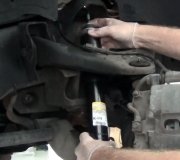Ford has a whole bunch of really bizarre suspension systems that cause a lot of crashes and tire wear problems, but your car isn't one of them. If you follow the instructions in the service manual, you will need three people and the car will have to be on a hoist to replace the springs. Special tools are needed too to compress the spring and to hold it in a curved shape to make prying it in easier. There's a lot of chances for injury too. There is an easier way. If you're going to be replacing the shock absorbers too, use a deep six-point socket on the upper nuts, and a long extension as a handle. Pound the socket on all the way then work the handle back and forth as far as possible to snap the stud off. It should only take about 15 seconds for it to snap off. That will not work with a 12 point socket. There's two bolts on the lower control arm to remove, then the shock will drop out the bottom. You might have to remove the anti-sway bar link if you have them. Put a block under the control arm between the two pivot bolts, then remove those bolts. There will be a lot of pressure on them so you'll have to raise and lower the car until the bolts can be tapped out easily. Once they're out, jack the car up to let the control arm drop down. You might have to pry it sideways a little. It's easiest to leave both tires on and let the car sit on the one you're not working on. The control arm only has to drop about three or four inches before all the pressure will be off the spring. If you're doing this on a hoist, you can remove the wheel, then pull down on the control arm to lift the spring out. If you're doing this on the ground, leave the wheel on and have a helper pull out on the bottom while you pull the control arm down and lift the spring out. The new spring is put in the same way but there are a few things to watch for. First, there is a pocket in the lower control arm where the spring sits. Remove any dirt and rocks, then find the end of the pocket. That's where the end of the spring must line up. If it is turned, the lower coil will walk up and raise the ride height too much. Most of these springs have a rubber insulator at the top. Don't rely on it sticking up there. It will fall down when you put the spring in and you won't see it out of position. Instead, use string or wire to tie it to the top coil of the spring. That will keep it in position while you put the spring in. Let the lower control arm come back and guide it under the spring. Once it's in position, jack the control arm up or block it and let the car down. Be careful that the control arm doesn't squirt out to the side. There will be a lot of pressure on it. As it gets close, use punches or screwdrivers to pull the mounting holes into alignment so you can insert the bolts. Don't tighten those bolts yet until both sides are done. Drive the car and bounce it a little to settle the suspension, THEN you can tighten the bolts. If you tighten them while the car is jacked up, it will hold the bushings in that position but it will put them into a permanent twist when the car is sitting at normal ride height. That will lead to their early failure. The last step is to have the front end aligned. Doing it this way on a hoist, one spring can be replaced in about 20 minutes without even removing the wheels. Doing it according to the service manual can take well over three hours on a hoist with three people, special tools, and a really long 4 foot pry bar. I never tried this on the ground but I suspect it will be at least a half day job.
Monday, March 21st, 2011 AT 12:06 AM


